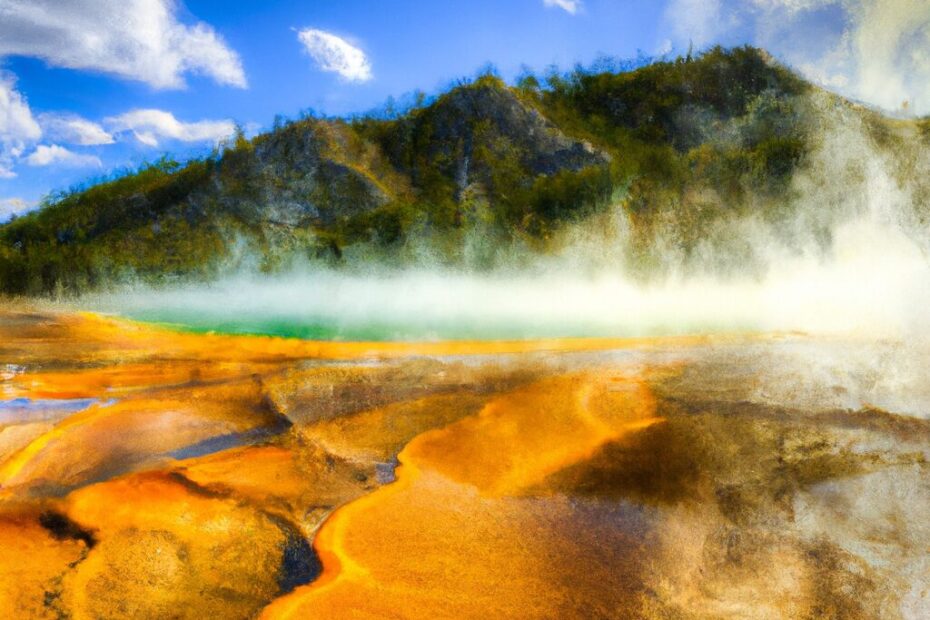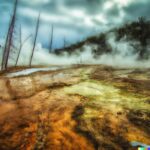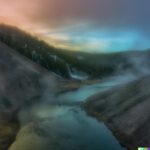Have you ever wondered about the mesmerizing natural wonders known as geysers? In this article, we will explore the enchanting world of geysers located in the iconic Yellowstone National Park. From the famous Old Faithful Geyser to the impressive Steamboat Geyser, we will delve into the unique characteristics and eruptions of these remarkable geothermal features. Join us on a journey to discover the beauty and power of Yellowstone’s notable geysers.
Full Yellowstone Notable Geyser Guide
Browse our directory below to learn more about notable Yellowstone National Park geysers.
- Introduction to Geysers in Yellowstone:
- Understanding Yellowstone Geysers:
- Why Yellowstone’s Geysers Are Unique:
- Famous Geysers in Yellowstone:
- The Science Behind Geyser Eruptions
- The Cultural Significance of Yellowstone Geysers
- The Environmental Impact of Geothermal Activity
- Visiting Yellowstone Geysers: Tips and Recommendations
Key Takeaways
- Old Faithful Geyser is the most famous geyser in Yellowstone National Park, erupting every 90 minutes with heights of up to 180 feet.
- Steamboat Geyser is the world’s tallest active geyser, with eruptions reaching up to 300 feet and occurring irregularly.
- Grand Geyser is known for its impressive eruptions that can last up to 12 minutes and reach heights of up to 200 feet, making it one of the largest geysers in the world.
What Are Geysers?
Geysers are natural geological formations typically found in volcanic regions, such as Yellowstone National Park, characterized by intermittent hot water eruptions driven by underground volcanic activity.
This phenomenon occurs when water seeps underground and comes into contact with hot rocks heated by magma chambers deep within the Earth. The heated water then rises back to the surface through fractures and vents, building up pressure until it forcefully erupts, creating the iconic plumes of scalding water and steam that geysers are known for.
Read More: View all of the articles in the Notable Geyser category
Yellowstone National Park is renowned for its high concentration of geysers, with the most famous being Old Faithful, which erupts at regular intervals. The park’s geothermal features are a result of the ongoing geological activity in the region, where magma chambers lie relatively close to the Earth’s surface, providing the heat source needed to power these spectacular displays.
Where Is Yellowstone National Park Located?
Yellowstone National Park is situated primarily in the U.S. states of Wyoming, with parts extending into Montana and Idaho, encompassing a vast area known for its geysers, hot springs, and diverse geology.
The park’s boundaries cover approximately 2.2 million acres, making it one of the largest national parks in the United States. Yellowstone’s location atop a volcanic hotspot is the reason behind its impressive geothermal features, including the famous Old Faithful geyser. Visitors to Yellowstone can witness a variety of wildlife such as bears, wolves, and bison roaming freely within the park’s boundaries.
What Makes Yellowstone National Park Unique?
Yellowstone National Park stands out for its exceptional geothermal features, including geysers, hot springs, fumaroles, travertine terraces, and the massive caldera resulting from past volcanic activity.
The park’s geysers, such as the world-famous Old Faithful, showcase mesmerizing eruptions of boiling water and steam, captivating visitors with their unpredictable nature. In addition, the colorful hot springs exhibit vibrant hues created by thermophiles, microorganisms thriving in extreme temperatures.
The terraces, notably at Mammoth Hot Springs, are striking formations crafted by mineral deposits from the flowing hot water, forming intricate and unique patterns over time.
Yellowstone’s geological wonders not only provide a peek into the Earth’s inner workings but also serve as habitats for diverse flora and fauna, adapted to thrive in these harsh yet mesmerizing environments.
What Are The Notable Geysers In Yellowstone National Park?
Yellowstone National Park boasts a remarkable collection of geysers, with each offering a unique spectacle of nature’s power and beauty, including iconic geysers like Old Faithful, Steamboat, Grand, Castle, Riverside, Beehive, Daisy, Giant, Sawmill, and Great Fountain.
Among these geysers, Old Faithful is perhaps the most famous and reliable, erupting approximately every 90 minutes with a height reaching up to 180 feet, captivating visitors with its predictability and splendor.
Steamboat Geyser, on the other hand, stands out as the world’s tallest active geyser, reaching heights of up to 300 feet during its infrequent but incredible eruptions, making it a must-see for geology enthusiasts.
Grand Geyser is known for its impressive performance with towering bursts that can last up to 12 minutes, while Castle Geyser’s distinctive cone shape and periodic explosions add to its allure.
Old Faithful Geyser
Old Faithful Geyser, located in Yellowstone National Park, is one of the most famous geysers globally, known for its predictably timed eruptions and impressive displays of natural thermal activity.
With a rich history dating back to its discovery in the mid-19th century by European explorers, Old Faithful has captivated visitors with its awe-inspiring eruptions that occur approximately every 90 minutes. This geyser stands out not just for the height and frequency of its eruptions, but also for its reliable schedule, making it a prime attraction in the park.
The distinctiveness of Old Faithful lies in its unique geological setting, where a narrow underground conduit delivers superheated water to the surface. The underground reservoir, fed by geothermal heat sources, plays a crucial role in the geyser’s spectacular displays.
Steamboat Geyser
Steamboat Geyser, situated in Yellowstone National Park, holds the title of the world’s tallest active geyser, captivating visitors with its sporadic but powerful eruptions that can reach incredible heights.
Its eruption patterns, unlike the predictable Old Faithful, are more irregular and infrequent, often going dormant for years before erupting with massive amounts of water and steam. Scientists are still studying the geological significance of Steamboat Geyser, trying to unravel the mysteries behind its unique behavior.
Grand Geyser
Grand Geyser in Yellowstone National Park is renowned for its majestic eruptions that reach impressive heights, showcasing the power and beauty of geothermal activity within the park’s diverse landscape.
The eruptions of Grand Geyser are known for their unpredictable nature, adding an element of excitement for visitors who eagerly anticipate the moment the geyser springs into action. With an average eruption frequency of about every 7 to 15 hours, witnessing this natural spectacle requires a bit of patience and a stroke of luck. The eruptions can last anywhere from 9 minutes to over 12 minutes, providing ample time to capture the geyser’s mesmerizing display. Its unique multistage eruption process, along with the mesmerizing water and steam columns that soar to the sky, make Grand Geyser a must-see attraction for anyone exploring the wonders of Yellowstone National Park.
Castle Geyser
Castle Geyser, an iconic thermal feature of Yellowstone National Park, captivates visitors with its unique cone structure and impressive eruptions that highlight the park’s geothermal wonders.
Its eruptions are truly a spectacle to behold, reaching heights of up to 90 feet and lasting around 20 minutes, making it one of the tallest geysers in the park. The geyser’s cone, adorned with vibrant hues from thermophiles thriving in the hot waters, stands out against the backdrop of the surrounding landscapes. Historically, Castle Geyser has been captivating onlookers since the 19th century, adding to its allure and significance within Yellowstone’s geothermal landscape.
Riverside Geyser
Riverside Geyser, located in the picturesque landscape of Yellowstone National Park, offers stunning eruptions that combine water, steam, and natural beauty in a mesmerizing display of geothermal activity.
Rising gracefully alongside the Firehole River, this geyser captures the essence of Yellowstone’s geothermal wonders. Visitors are captivated by Riverside Geyser’s predictable eruptions that soar up to 75 feet in the air, enveloped in plumes of steam against the backdrop of lush greenery and vibrant wildflowers.
The geyser’s cone, formed from mineral deposits, adds to its mystique, accentuating the contrast between its white structure and the vivid hues of the surrounding geothermal pools and terraces. This harmonious blend of nature’s elements makes Riverside Geyser a must-see attraction for those exploring the park’s hydrothermal features.
Beehive Geyser
Beehive Geyser, nestled within the geothermal wonders of Yellowstone National Park, delights spectators with its cone-shaped eruptions that resemble the natural beauty of a beehive, adding to the park’s unique charm.
This iconic geyser showcases eruptions that soar impressively up to 200 feet in the air, captivating onlookers with its powerful display that embodies the raw force of nature. Visitors eagerly anticipate its eruptions, which typically occur every 8 to 24 hours, offering a thrilling and unpredictable spectacle that never fails to amaze. The steam and water jets shoot out in a pulsating rhythm, creating a mesmerizing visual spectacle against the park’s stunning backdrop. Its intricate cone structure, formed over millennia, adds to the geyser’s mystique, making it a must-see attraction for nature enthusiasts.
Daisy Geyser
Daisy Geyser, a beloved thermal feature of Yellowstone National Park, enchants onlookers with its frequent but graceful eruptions that embody the park’s geothermal charm and natural splendor.
Its eruption patterns, resembling a delicate dance between earth and water, often captivate spectators with their mesmerizing display of power and beauty. Daisy Geyser’s eruptions, while not the largest in the park, hold a unique allure due to their consistent frequency, allowing visitors to witness nature’s rhythmic spectacle up close and personal.
Giant Geyser
Giant Geyser, a spectacular thermal wonder in Yellowstone National Park, showcases powerful eruptions that captivate observers with their grandeur and natural display of the park’s geothermal activity.
Its eruptions can reach heights of over 200 feet, making it one of the tallest geysers in the world. The unique feature of Giant Geyser lies in its infrequent yet impressive eruptions, with intervals ranging from several days to even years. This irregular pattern adds to the anticipation surrounding its next outburst, drawing crowds of eager onlookers. The geological significance of Giant Geyser extends beyond mere spectacle, contributing to the dynamic landscape of the park and the understanding of geothermal processes.
Sawmill Geyser
Sawmill Geyser, nestled within the geysers of Yellowstone National Park, offers intermittent eruptions that mesmerize visitors with their rhythm and natural beauty, adding to the park’s diverse thermal attractions.
What sets Sawmill Geyser apart is its unique eruption pattern, characterized by sporadic bursts that can reach impressive heights, thrilling onlookers with its unpredictable nature. The geyser’s visual appeal is heightened by the surrounding colorful mineral deposits, creating a picturesque setting against the park’s vibrant landscape. In the historical context, Sawmill Geyser has been a key player in shaping the geothermal features of Yellowstone, contributing to the ongoing geological processes that make the park a treasure trove of natural wonders.
Great Fountain Geyser
Great Fountain Geyser, a majestic thermal feature of Yellowstone National Park, mesmerizes spectators with its impressive eruptions and intricate terraces, showcasing the park’s geothermal diversity and natural splendor.
The eruption patterns of Great Fountain Geyser are awe-inspiring, often reaching heights of up to 200 feet, making it one of the top attractions for visitors seeking the wonders of geothermal activity in the park. The geyser’s terraces, formed by the mineral-rich waters, create a stunning visual display of vibrant colors and intricate formations that continue to evolve over time.
- Its historical significance dates back to the early explorers who marveled at its beauty and power, solidifying its place as an iconic symbol of Yellowstone’s geothermal marvels.
- Witnessing an eruption of the Great Fountain Geyser is not just a visual spectacle, but a reminder of the natural forces that shape this unique landscape.
What Are The Eruptions Of These Geysers Like?
The eruptions of geysers in Yellowstone National Park are captivating displays of nature’s power, featuring bursts of hot water, steam, and sometimes colorful mineral formations, creating a mesmerizing spectacle for visitors.
These geysers, such as the iconic Old Faithful, erupt at various intervals, ranging from minutes to days apart, with each eruption showcasing its own unique flair.
The eruption dynamics vary from gentle, steady streams to explosive gushes that can reach incredible heights, adding to the excitement of witnessing these natural wonders.
Geologists attribute the geysers’ eruptions to the heating of groundwater by magma beneath the surface, causing pressure to build up until it erupts in a spectacular fashion.
Old Faithful Geyser Eruptions
The eruptions of Old Faithful Geyser in Yellowstone National Park are renowned for their regularity, duration, and impressive heights, captivating spectators with a mesmerizing display of geothermal power and natural beauty.
Old Faithful Geyser boasts a consistent eruption cycle, typically spouting water and steam every 60 to 110 minutes, reaching heights averaging around 130 feet. This predictable pattern has made it a beloved attraction for visitors and a subject of scientific curiosity for researchers studying geothermal activity. The visual spectacle of the eruptions, combined with the geyser’s historical significance as one of the park’s most famous features, contributes to its iconic status within Yellowstone.
Steamboat Geyser Eruptions
The eruptions of Steamboat Geyser in Yellowstone National Park are notable for their sporadic nature and remarkable heights, creating awe-inspiring displays of geothermal activity that draw visitors from around the world.
The unique eruption characteristics of Steamboat Geyser set it apart from other geysers in the park, with its infrequent but powerful bursts of scalding water and steam shooting up to incredible heights, sometimes reaching over 300 feet.
These geological phenomena provide a captivating spectacle for park visitors, offering a glimpse into the raw power of nature at work in the geothermal landscape.
The geyser’s eruptions play a crucial role in the dynamic evolution of Yellowstone’s geology, contributing to the ever-changing thermal features that shape the park’s unique ecosystem.
Grand Geyser Eruptions
The eruptions of Grand Geyser in Yellowstone National Park are renowned for their majestic heights and impressive visual displays, showcasing the power and beauty of geothermal activity within the park’s unique landscape.
Grand Geyser, one of the world’s tallest predictable geysers, erupts at regular intervals, shooting boiling water and steam over 200 feet into the air. The geyser’s eruptions follow a mesmerizing pattern, starting with a series of steam bursts before the main eruption, creating a spectacle that captivates visitors from around the globe.
Castle Geyser Eruptions
Castle Geyser’s eruptions in Yellowstone National Park are characterized by their impressive cone formations and unique visual displays, adding to the park’s rich tapestry of geothermal wonders and natural beauty.
The eruptions of Castle Geyser are known for their remarkable frequency and duration. These explosive eruptions can reach up to 90 feet in height, captivating visitors with the power of nature. The visual appeal of Castle Geyser’s eruptions is heightened by the surrounding landscape, creating a spectacular scene against the backdrop of the park’s diverse flora and fauna. Historically, Castle Geyser has been a prominent feature of Yellowstone National Park, drawing attention to the geological forces at work beneath the surface.
Riverside Geyser Eruptions
Riverside Geyser’s eruptions in Yellowstone National Park offer a captivating blend of water and steam, creating stunning displays of geothermal activity amidst the park’s scenic beauty and natural landscapes.
These eruptions are known for their rhythmic patterns, with intervals lasting approximately every 6 to 7 hours, drawing in awe-inspired spectators from all corners of the park. The unique feature of Riverside Geyser is its towering height, reaching up to 75 feet during its eruptions, making it one of the remarkable sights in the park.
As the geyser spouts its scalding water high into the air, the steam adds a mystical quality to the surrounding environment, creating a surreal atmosphere that mesmerizes onlookers. The juxtaposition of the geyser against the backdrop of the lush greenery and the meandering river enhances the visual aesthetics, offering a picturesque scene that embodies the essence of Yellowstone’s geothermal wonders.
Beehive Geyser Eruptions
Beehive Geyser’s eruptions in Yellowstone National Park mimic the beauty and intricacy of a beehive, captivating spectators with their cone-shaped displays and natural geothermal wonders that add to the park’s unique allure.
The eruptions of Beehive Geyser are not only visually stunning, but they also hold a historical significance within Yellowstone National Park. With a height reaching up to 200 feet, the geyser’s eruptions are known for their impressive power and unpredictability, attracting visitors from all over the world.
Daisy Geyser Eruptions
Daisy Geyser’s eruptions in Yellowstone National Park offer graceful displays of thermal activity, blending water and steam in a mesmerizing showcase of nature’s power and beauty within the park’s geothermal landscape.
These eruptions follow a somewhat predictable schedule, occurring every 110-115 minutes, thrilling visitors with their reliability and consistency. The sight of water shooting up high into the air, accompanied by billowing clouds of steam, creates a spectacle that is both awe-inspiring and calming. One of the most unique features of Daisy Geyser is its distinctive cone shape, showcasing the forces of nature at work over time. This geyser’s eruptions hold a special place in the history and allure of Yellowstone National Park, drawing in visitors from around the world.
Giant Geyser Eruptions
Giant Geyser’s eruptions in Yellowstone National Park are grand spectacles that showcase the raw power and beauty of geothermal activity, mesmerizing visitors with towering displays of thermal energy within the park’s diverse landscape.
These eruptions, characterized by their sporadic frequency and immense heights reaching up to 200 feet, make Giant Geyser a standout feature within the Upper Geyser Basin. The geyser’s unique eruption patterns, which can last anywhere from several hours to a few days, add to its mystique and geological significance. Scientists closely study the eruptions of Giant Geyser to gain insights into the underlying magma chambers and hydrothermal systems that fuel its spectacular displays.
Sawmill Geyser Eruptions
Sawmill Geyser’s eruptions in Yellowstone National Park offer rhythmic displays of thermal activity, blending water and steam in a mesmerizing showcase of geothermal wonders amidst the park’s unique landscapes and natural beauty.
The intervals between Sawmill Geyser’s eruptions are varied, often ranging from hours to possibly days, adding an element of anticipation for visitors eager to witness its next outburst.
The visuals during these eruptions are truly captivating, with towering columns of water and steam reaching impressive heights, creating a spectacle that showcases nature’s raw power and beauty.
Historically, the eruptions of Sawmill Geyser have been both a draw for tourists and a subject of scientific study, providing valuable insights into the dynamic geothermal processes at work within Yellowstone National Park.
Great Fountain Geyser Eruptions
Great Fountain Geyser’s eruptions in Yellowstone National Park offer impressive displays of thermal activity, featuring intricate terraces and towering eruptions that showcase the park’s diverse geothermal landscape and natural wonders.
The eruption patterns of Great Fountain Geyser are known for their unpredictability, adding an element of thrill for visitors who eagerly anticipate the breathtaking displays. These eruptions can soar up to 200 feet in height, making them some of the tallest in Yellowstone. The terraces surrounding the geyser are created by mineral deposits, forming mesmerizing patterns that delineate the history of past eruptions. The visual appeal of these natural formations is enhanced by the vibrant colors imparted by heat-loving microorganisms, showcasing a harmonious blend of geology and biology.
Frequently Asked Questions
What are some notable geysers found in Yellowstone National Park?
Some notable geysers found in Yellowstone National Park include Old Faithful, Grand Geyser, Castle Geyser, and Steamboat Geyser.
What makes Old Faithful such a popular attraction in Yellowstone National Park?
Old Faithful is known for its predictable and impressive eruptions, which occur approximately every 90 minutes and can reach heights of 100-180 feet.
How often does Grand Geyser erupt?
Grand Geyser is the tallest predictable geyser in the world and erupts approximately every 8-12 hours, with eruptions lasting up to 12 minutes.
Are there any unique characteristics of Castle Geyser?
Yes, Castle Geyser is known for its distinctive cone shape and diamond-shaped eruptions, which can reach heights of 90 feet.
What is the significance of Steamboat Geyser?
Steamboat Geyser is the tallest active geyser in the world and is known for its infrequent but powerful eruptions, which can reach heights of up to 380 feet.
Are there any other notable geysers in Yellowstone National Park?
Yes, there are many other notable geysers in Yellowstone National Park, including Beehive Geyser, Riverside Geyser, and Grand Prismatic Spring.
Last Updated on February 18, 2024 by Jon Waraas – Originally Posted: February 8, 2024

I’m Jon Waraas, and I’ve been navigating the online world since 2006. By day, I’m the proud owner of some eCommerce gems, and by night, I’m the voice behind the adventures on Waraas.Com.
My heart, however, belongs to the wild beauty of Yellowstone National Park. I’ve got a collection of websites dedicated to sharing the wonders of this natural masterpiece. Oh, and did I mention? I’m currently building my own cabin inside the ghost town of Gilmore, Idaho – a cabin with tales to tell!
When I’m not immersed in the digital realm, you’ll find me lacing up my boots for a good hike or setting up camp under the star-studded sky.




